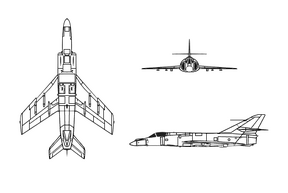The Dassault Super Etendard is a French naval based fighter-bomber created in 1974 as a low-cost replacement of the Dassault Etendard IV.
Description[]
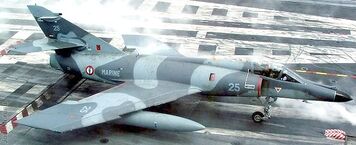
Dassault Super Etendard of the French Navy
The Super Etendard was developed by Dassault as a low-cost version of the naval fighter Dassault Etendard-IVM.
Among the changes introduced was the engine change, because the Super-Etendard started using Atar 8K50 engine, which alone gave the new plane much higher capacities. Besides the engine, the Super Etendard received modified wings, with the leading edges inclined. Also now used a new radar, Thomson-CSF Agave, best suited for naval missions, along with a new navigation system optimized for attack missions. These characteristics have led to the Super Etendard aircraft was classified as protection of the fleet from attack by enemy ships, along with the role of ground attack. The aircraft would then attack the function of points on land, building on the French aircraft carrier Foch (now A-12 São Paulo) and Clemenceau. However, he was not able to compete with supersonic aircraft at that time were already in operation. The protection function of the squadron, allowed the Super Etendard attack enemy ships, but the function of protecting and defending against aircraft were restricted to the F-8 Crusader. The Super Etendard was not a sales success, especially because as an aircraft to operate from conventional aircraft carrier, the market was reduced. To complicate the things the Super Etendard was much more expensive than its main rival the fighter A-4 Skyhawk. As the strike aircraft based on land, he also had several rivals cheaper and equally effective in the role as the BAE Hawk and Alpha Jet.
Operational History[]
Argentina[]
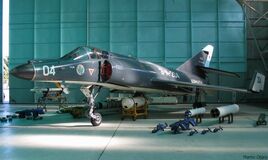
Super Étendard of the Argentine Navy
The Argentine Navy purchased 14 Super Étendards in 1980, after the United States denied the possibility of replacing its A-4Q Skyhawks. There was an "Arms Embargo" due to violations of human rights because of the Cold War.
The Argentine pilots had used the French aircraft in training between November 1980 and August 1981 in France, but the outbreak of the Falklands War, had received only 45 hours of flight in this aircraft type. Between August and November 1981 five and five Super Etendards Exocets were sent to Argentina. The five missiles were used during the conflict, a missile destroyed the HMS Sheffield and one in support ship Atlantic Conveyor employing two missiles in each of the attacks. The fifth missile was launched against the HMS Invincible. British sources report that was destroyed by friendly fire from HMS Avenger for a 114 mm cannon.
Soon after the Falklands War, the Command of Naval Aviation (COANA) of Argentine Navy received the remaining units that did complete the 14 aircraft orders. After the reforms of the aircraft carrier ARA Veinticinco de Mayo (V-2) (POMA), began operations, forming part of its GAE (Grupo Aeronaval Embarcado, Naval Embedded Group in English) on April 18 of 1983, el Corvette Captain Augusto Bedacarratz, landed the first time in V-2. By mid-1988 remain part of the EAG, along with the Grumman S-2 Tracker and the McDonnell Douglas A-4 Skyhawk at this date, 25 de Mayo came into reforms that were never completed and the ship was finally scrapped in the late 90 in Alang, India.
Without being able to operate in an aircraft carrier itself, the pilots of the Super Etendards continued training on board the complex operation, the Commander Naval Air Spur is a part of its track modified to simulate
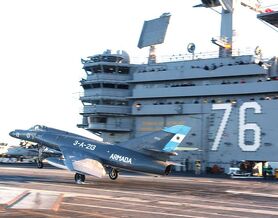
Argentine Super Etendard taking of from the U.S Aircraft Carrier USS Ronald Reagan (CVN-76)
landings hooked on an aircraft carrier. Also, each time a Battle Group of an aircraft carrier of U.S. Navy sails near the territorial waters of Argentina takes advantage to make PyAD that are landing and takeoff practice on the American ship. With the Brazilian Navy desenvolmeram ARAEX the exercises, in which aircraft were operating in the Argentine aircraft carrier NAeL Minas Gerais (A-11), but the limitations of catapults in the same limited activities to practice "touch and go."
Between May 2 and May 5 of 2002, held a historic fact, when the aircraft carrier NAe São Paulo of Brazilian Navy sailed into the Atlantic south to develop the exercise ARAEX VI and allowed an GAE mixed, composed of Brazilians and Argentines planes. On one occasion, three Super Étendards operated effectively (with landings and catapultagens) on the aircraft carrier in Brazil.
Actively participate in the exercises (called Stages of the Sea), with airplanes and helicopters Comando Naval Aviation (COANA), along the Sea Fleet vessels (COFN), Division of Maritime Patrol (DVPM makes) and the submarines of the Command of Submarine Force (COFS).
France[]
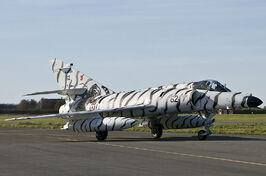
French Dassault Entendard Modernise (SEM) with Tiger Stripe camouflage during the Tiger Meet
Since 1991, the original Etendards IVMs were removed from service in the French Navy, and the Super Étendards underwent continuous modernization in 90 years to be able to use them with weapons-art laser guided. These changes increased the plane and came to be called Super Etendards Modernisé (SEM), which participated in the operations of NATO over Kosovo in 1999 as part of 400 combat missions. The SEM also participated in combat operations in Operation Enduring Freedom.
It is expected that all Super Étendards are withdrawn from service in 2010, which are being replaced since 2006 by Dassault Rafale.
Iraq[]
Iraq made a deal with France in 1984, which led to the lease of five Super Etendard aircraft to the regime of Saddam Hussein, when he was at war with Iran
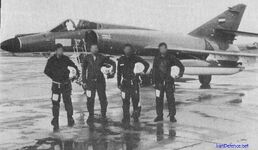
Iraqi Super Étendard and its crew during the Iran-Iraq War
Apparently, the aircraft supplied to Iraq were part of the nine whose delivery had been canceled by France, when it passed an embargo on arms sales to Argentina. The nine planes would be turned over later.
There are not many details on this use of the Super Etendard in Iraq, but it is known that the first operation took place in March 1984, and that although several targets have been reached, there was no sinking of any ship. The Super Etendard were returned to France the following year, 1995. According to available data, the five provided only three have been returned, having lost two, one killed by Iranians and other lost in an accident.
Specifications[]
General Characteristics[]
- Crew: 1
- Length: 14.31 m (45 ft 11½ in)

Sketch of the Super Etendard
- Wingspan: 9.60 m (31 ft 6 in)
- Height: 3.86 m (12 ft 8 in)
- Wing area: 28.4 m² (306.7 ft²)
- Empty weight: 6,500 kg (14,330 lb)
- Max takeoff weight: 12,000 kg (26,455 lb)
- Powerplant: 1× SNECMA Atar 8K-50 turbojet, 49.0 kN (11,025 lbf)
Performance[]
- Maximum speed: 1,180 km/h (637 knots, 733 mph) at low level
- Range: 1,820 km (983 nmi, 1,130 mi)
- Combat radius: 850 km (460 nmi, 530 mi) with one AM39 Exocet missile one wing pylon and one drop tank on opposite pylon, hi-lo-hi profile
- Service ceiling: 13,700 m (44,900 ft)
- Rate of climb: 100 m/s (19,700 ft/min)
- Wing loading: 423 kg/m² (86.3 lb/ft²)
- Thrust/weight: 0.42
Armament[]
- Guns: 2× 30 mm (1.18 in) DEFA 552 cannons with 125 rounds per gun
- Hardpoints: 4× underwing and 2× under-fuselage with a capacity of 2,100 kg (4,600 lb) maximum
- Rockets: 4× Matra rocket pods with 18× SNEB 68 mm rockets each
- Missiles:
- 1× AM-39 Exocet Anti-shipping missile or
- 1× Air-Sol Moyenne Portée nuclear armed missile or
- 2× AS-30L or
- 2× Matra Magic Air-to-air missile
- Bombs: Conventional unguided or laser-guided bombs, provision for 1 × AN-52 free-fall nuclear bomb, provision for "buddy" air refuelling pod
See also[]
The original article can be found at Dassault Super Etendard and the edit history here.
